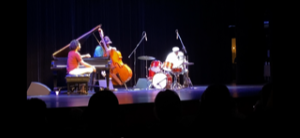Susan Fancher: In Two Worlds. Innova Recordings 736; one CD, $15.98. Electronics recorded by Mark Engebretson et al, with collaborative recording at the UNC Greensboro’s School of Music Recital Hall and Organ Hall.
Susan Fancher‘s new CD In Two Worlds aptly describes not only the material and methods of the title work by Morton Subotnick (1987/2007) but the genre’s combined worlds of solo saxophone with electronic sound, a challenging performance medium ideally suited to Fancher’s considerable artistic and technical abilities.
This recording immerses the listener in seven unique environments that range from tranquil to dramatic, worlds inhabited by forces and sounds that defy definition. Shimmering creatures and exotic birds populate “Jovian Images” (Reginald Bain, 2008), and “SaxMax” (Mark Engebretson, 2006) teases the ear with allusions to the sea, bird-like patter on its beach, and ephemeral strains of a distant jazz club.
“Penelope’s Song” (Judith Shatin, 2004/2007) contains the most overtly referential material. Dedicated to Homer’s Queen of Ithaca who employed weaving to rebuff suitors, the work’s ostinato is sampled from the sounds of a wooden loom. This rhythmic element gives forward motion to the music, and sets the work apart from the others in that respect.
Edmund Campion intended extra-musical associations when composing “Corail” (2001). He writes that “only when human culture moves within an ecological niche can it relate appropriately with all the fields of forces of nature.” This view is expressed via the saxophone’s improvisation within computer-generated manipulations of its own sounds.
In “Slammed” (James Paul Sain, 2006), the saxophone’s melodic line seems blissfully unaware of its malevolent surroundings. But foreboding gives way to “Aeterna” (John Anthony Lennon, 1996), a sublime piece built upon the concept of unfoldings. The composer makes use of alternate fingerings in rapid interchange, which enhances minimalistic patterns and yields percussive effects.
The electronically produced sounds on this recording demonstrate the vast creativity of composers unconfined by the limitations of physical instruments and human ability. But Susan Fancher’s stunning performances seem equally unfettered, and her presence is the high touch balance to the high tech. She is an eminently capable and virtuosic guide through the sophisticated landscapes of In Two Worlds, a journey well worth taking.











